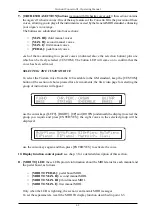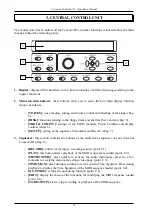
78
Viscount Concerto III - Operating Manual
INFORMATION ABOUT THE DISPLAY PAGES
During display of video pages, two arrows may appear on the right of the display, informing
the user that further display pages are available. A downward-pointing arrow indicates that
there is another following page, accessible using the [CURSOR (PG) DOWN] button.
Conversely, a previous page is indicated by an upward-pointing arrow; to display it press the
[CURSOR (PG) UP] button.
A BRIEF NOTE ON TEMPERAMENTS
In the “natural” tuning system, based on the acoustic phenomenon of harmonic voices, two important musical intervals,
the major third and the perfect fifth, cannot be made to coexist in the “pure” state (i.e. beat-free). Therefore, over the
centuries a variety of compromise solutions known as
TEMPERAMENTS
have been invented and realised.
These give the priority to one interval or the other, and modify them in various ways..
In ancient times and in the Middle Ages, until the end of the 15
th
Century, the “Pythagorean” tuning system, in which
the fifths were kept perfectly pure, was used. The resulting major third interval was particularly unpleasant and was
therefore considered a dissonance. However, the music of the time was mainly monodic and the first vocal and
instrumental polyphonic forms made wide use of the interval of a fifth. With the early Renaissance and the start of the
great age of vocal polyphony, the interval of a major third gradually came to be heard as a consonance. The instruments
with fixed tuning, such as the organ and harpsichord, were adapted to this situation by using a system of temperament
known as meantone, which gave priority to the major third over the fifth. This temperament is particularly important
since it was in normal use in Europe in the 16
th
and 17
th
Centuries, until the beginning of the 18
th
. Here are the six
temperaments offered by the Concerto III, first of all the MEANTONE.
MEANTONE
-
8 pure major thirds: E flat – G / B flat – D / F – A / C – E / G – B / D – F # / A – C# / E – G.
-
4 unusable major thirds (diminished fourths): B – D# / F# - A# / C# - E# / A flat - C.
-
1 fifth known as the “wolf” (very dissonant extended fifth): G# - E flat.
-
Highly irregular chromatic scale (meaning that chromatic compositions are given a very distinctive voice)
-
Keys usable with this temperament: C maj. / D maj. / G maj. / A maj. / B flat maj. and the relative minors.
The temperaments which follow allow all the major and minor keys to be used, although those with the most alterations
have a highly distinctive voice, in contrast with the modern equal temperament.
WERCKMEISTER
This temperament, invented by the organist and musical theorist Andreas Werckmeister, is recommended for performing
the German musical repertoire of the late 1600s.
KIRNBERGER
This temperament, developed by Johann Philipp Kirnberger, pupil of J.S. Bach, is also suitable for playing the German
baroque composers and the works of Bach.
VALLOTTI
This Italian temperament by Francescantonio Vallotti was later reworked in England by Thomas Young. It can be used
effectively for the Italian 18
th
Century repertoire, and also for the English repertoire of the same period.
PYTHAGOREAN
This temperament, in which the fifths were preserved perfectly pure, dates from the Middle Ages up to the 15
th
century,
and can therefore be used for compositions of that period.
















































